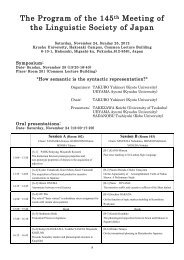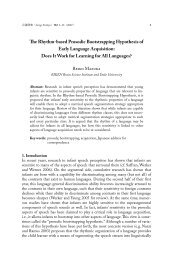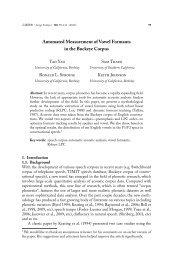第117åæ¥æ¬è§£åå¦ä¼ç·ä¼ã»å ¨å½å¦è¡éä¼ è¬æ¼ããã°ã©ã ã»æé²é PDF ...
第117åæ¥æ¬è§£åå¦ä¼ç·ä¼ã»å ¨å½å¦è¡éä¼ è¬æ¼ããã°ã©ã ã»æé²é PDF ...
第117åæ¥æ¬è§£åå¦ä¼ç·ä¼ã»å ¨å½å¦è¡éä¼ è¬æ¼ããã°ã©ã ã»æé²é PDF ...
Create successful ePaper yourself
Turn your PDF publications into a flip-book with our unique Google optimized e-Paper software.
117 69<br />
S<br />
The role of autophagyrelated proteins on lipid<br />
metabolism in the ER membrane<br />
Taki Nishimura 1 , Anoop Kumar Velikkakath 1 ,<br />
Naotada Ishihara 1,2 , Eiko Oita 1 , Noboru Mizushima 1<br />
1<br />
Dept. Physiol. Cell Biol., Tokyo Med. Dent. Univ., 2 Dept. Protein<br />
Biochem., Inst. Life Sci., Kurume Univ.<br />
Autophagy is an intracellular degradation system accompanied by<br />
dynamic membrane organization. Dynamic membrane remodeling is<br />
achieved by the interplay between lipids and proteins and modulated<br />
by changes in lipid composition. However, the role of autophagyrelated<br />
genes in the lipid metabolism remains elusive. Here we<br />
show that endogenous Atg2A localizes on the autophagic isolation<br />
membranes and LDs. Atg2A and Atg2B are essential for autophagy<br />
because autophagic flux is blocked in cells treated with siRNA against<br />
both Atg2A and Atg2B, although LC3-II is generated. Morphological<br />
and biochemical analyses of Atg2-depleted cells reveal accumulation<br />
of aberrant membrane structures, which contained other Atg proteins<br />
such as LC3 and Atg9. These structures may represent intermediate<br />
structures of autophagosome formation. In addition, LD turnover<br />
is also affected in Atg2-depleted cells. These data suggest that<br />
mammalian Atg2 homologues are required for autophagosome<br />
formation and have an additional role in LD turnover, both of which<br />
take place on the endoplasmic reticulum. Now we are analyzing the<br />
effect of other autophagy-related genes RNAi on the LDs turnover.<br />
S<br />
ApoB <br />
<br />
<br />
<br />
<br />
<br />
Huh7 <br />
ApoB <br />
ApoBcrescent ApoBcrescent <br />
<br />
ApoB <br />
ApoB <br />
Huh7 <br />
UBXD2UBXD8p97 <br />
UBXD2 UBXD8 p97 <br />
UBXD8 ApoB <br />
UBXD8 knockdown ApoBcrescent <br />
ApoB UBXD8/p97 <br />
UBXD8 <br />
Derlin1 <br />
ApoBcrescent <br />
Derlin1 knockdown UBXD8 ApoB <br />
<br />
ApoB Derlin1/UBXD8/p97 <br />
<br />
<br />
S<br />
<br />
DGK<br />
<br />
<br />
DG<br />
<br />
DG C <br />
DG <br />
DG <br />
DG <br />
DG DGK DG <br />
<br />
DG <br />
DGK <br />
DGKDGKζ<br />
<br />
<br />
DGKζ <br />
<br />
DGKζ NMDA<br />
<br />
DGKζ <br />
<br />
DGKζ <br />
p53 <br />
<br />
S<br />
<br />
<br />
<br />
Long chain fatty acids are important nutrients for brain development<br />
and function. However, the molecular basis of their actions in<br />
the brain is still unkown. Fatty acid-binding proteins (FABPs),<br />
intracellular chaperons of fatty acids, are involved in the promotion<br />
of cellular uptake and transport of fatty acids, the targeting of fatty<br />
acids to specific metabolic pathways, and the regulation of gene<br />
expression. We have so far revealed that FABP7, a strong binder<br />
of omega-3 PUFA, is involved in controlling fatty acid metabolism<br />
in the brain astrocytes and that its deficiency in mice results in the<br />
alteration of emotional behavioral responses. In this talk, I would<br />
introduce the possible mechanism by which FABP7 controls neuronal<br />
plasticity through regulating lipid metabolism in the astrocytes, and<br />
discuss the link of FABP- and/or PUFA-deficiency to the human<br />
psychosis including schizophrenia.







